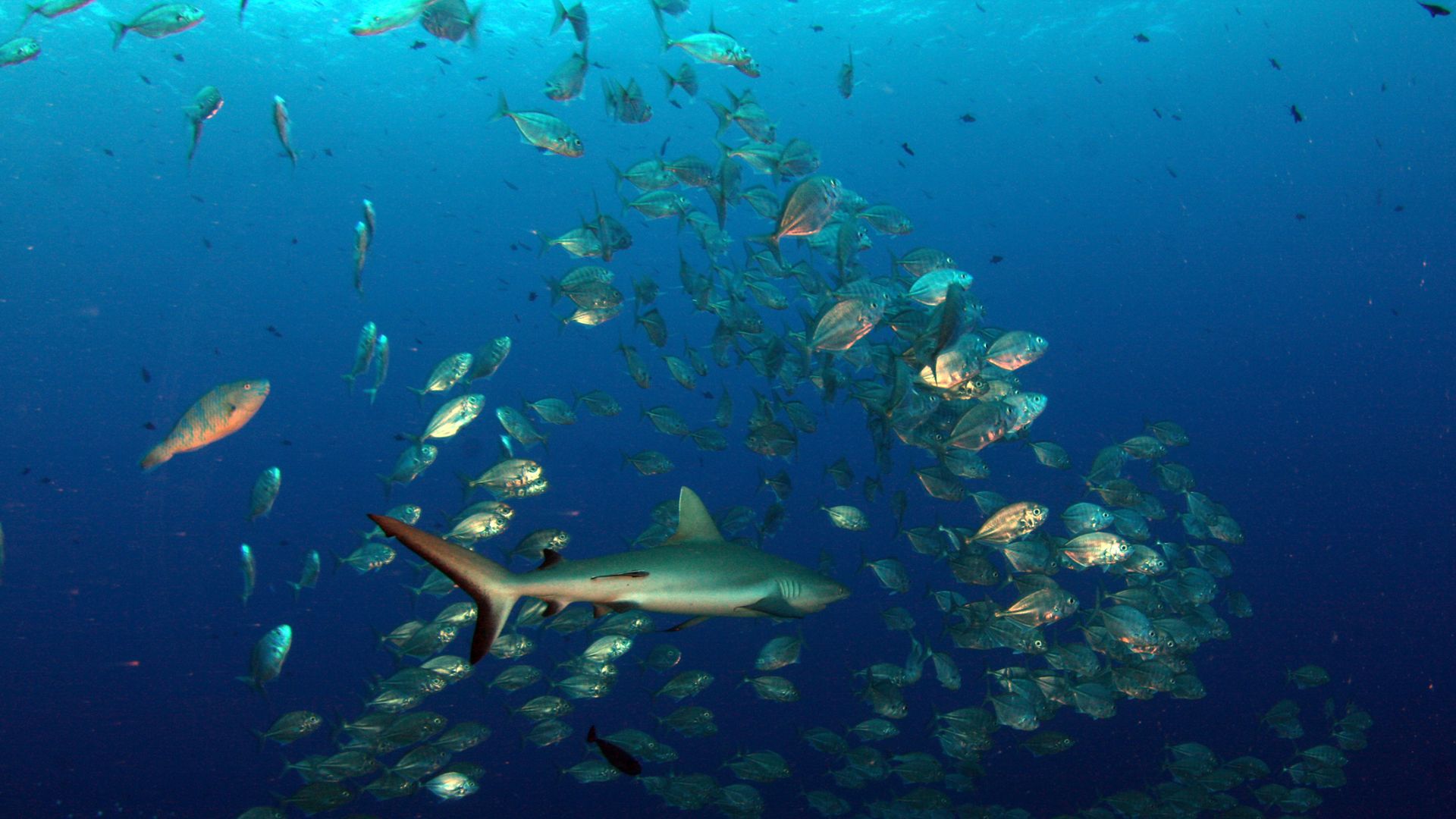
Shark Attacks: What happens and how to stay safe
Sharks are often feared for their reputation as dangerous predators, especially following highly-publicised attacks or portrayals in movies. However, the reality is that shark attacks are exceedingly rare when compared to other dangers in the ocean, such as drowning, rip currents, and stings from jellyfish. In fact, the chances of encountering a shark while swimming or surfing are extremely slim.
In this article, we’ll take a closer look at what actually happens during a shark attack, how to minimise the risk of such encounters, and what to do if you do find yourself in a situation with one of these majestic creatures:
- What happens during a shark attack?
- Why sharks bite
- Types of Shark Attacks
- How to prevent shark attacks
- What to do if you encounter a shark
- Understanding shark behaviour

What happens during a shark attack?
Sharks are often depicted as ferocious predators in films, but the reality of shark attacks is more complex. The physiology behind a shark’s attack is a combination of instinct, curiosity, and sometimes confusion.
During a shark attack, the shark typically strikes quickly and with great force, using its powerful jaws to bite. The initial bite is often exploratory, as sharks are not targeting humans as food but rather trying to determine if the object is something worth eating. This bite is often a single, sharp encounter, followed by the shark retreating. In many cases, the shark realises that the human is not its usual prey, such as a seal, and swims away. The shark’s instinct to bite first and assess later comes from its predatory nature, where it often relies on surprise and speed to catch its prey. However, this behaviour, though unsettling, is generally not lethal, and most shark attacks are not followed by repeated attacks or fatal outcomes. The shark’s bite may cause injury, but fatalities are extremely rare. The shark, after assessing the situation, often loses interest and swims away, further proving that humans are not the primary target for these apex predators.
Why sharks bite
A shark bite is typically not a predatory attack but rather a case of curiosity or mistaken identity. Sharks are naturally inquisitive creatures, and their sharp senses allow them to detect potential prey from great distances. When a shark encounters something unfamiliar, such as a swimmer or surfer, it might bite to investigate whether it is something worth eating. Unfortunately, this initial bite is often hard to distinguish from a predatory strike, but it’s usually a single bite to assess the object. Once the shark realises that the human is not its usual prey, it typically swims away.

Types of Shark Attacks
Shark attacks can be categorised into two types: unprovoked and provoked. An unprovoked attack occurs when a shark bites a human without any direct interaction or disturbance. These attacks are rare and usually occur when a shark mistakes a swimmer or surfer for its natural prey, like a seal. For example, many attacks occur in waters where seals are abundant, such as along the coast of South Africa or California. On the other hand, a provoked attack happens when a human deliberately or accidentally disturbs a shark’s territory. This can include actions like trying to touch or capture a shark, or swimming too close to a shark’s hunting grounds.
While both types of attacks are tragic and frightening, they are still incredibly rare when considering the millions of people who enter the ocean each year. In fact, sharks are responsible for an average of just 10 fatalities worldwide per year, which is minuscule when compared to other risks we face in the water.
“Shark attacks are rare, and when they happen, they’re often a case of curiosity, not predation—reminding us that these creatures aren’t monsters, but misunderstood hunters.”
How to prevent shark attacks
While shark attacks are uncommon, understanding shark behaviour and taking the proper precautions can help minimise the risk of an encounter. Here are some important safety tips for swimming, surfing, and diving in shark-prone waters.
Stay in groups
Sharks are more likely to attack solitary individuals. When swimming or surfing, try to stay in groups, as sharks tend to target lone individuals, thinking they are isolated prey. The presence of multiple people can help deter a shark’s curiosity.
Avoid swimming at dusk or dawn
Sharks are most active during the early morning and late afternoon when they are hunting for food. Swimming during these times can increase the risk of encountering a shark, as the low light conditions make it harder for sharks to distinguish between their usual prey and humans.
Be cautious around schools of fish or seals
Sharks are drawn to areas where schools of fish or seals are abundant, as these are their primary food sources. If you see large schools of fish or seals in the water, it’s best to steer clear, as sharks may be hunting in these areas.
Avoid shiny jewellery
Sharks are attracted to shiny objects, which resemble the scales of small fish. Avoid wearing jewellery, such as bracelets or necklaces, when swimming in the ocean to reduce the risk of attracting a shark.
Don’t swim in murky water
Sharks rely heavily on their sense of smell and electroreception to detect prey. Swimming in murky or cloudy water increases the chances that a shark may mistake you for a seal or fish. If the water is unclear, it’s best to stay out of it.
What to do if you encounter a shark
If you find yourself in a situation where you encounter a shark, it’s essential to stay calm and react appropriately. While the idea of a shark encounter can be terrifying, your actions can make a significant difference in the outcome. Here’s what to do if you see a shark in the water:
Stay calm
The most important thing in any shark encounter is to remain calm. Panicking and thrashing around in the water can attract the shark and increase the likelihood of an attack. Take slow, deliberate movements to avoid drawing unnecessary attention.
Maintain eye contact
Sharks often attack from below, so it’s essential to keep eye contact with the shark. This makes you appear more aware and less like prey. If the shark continues to approach, slowly move backwards towards the shore or your boat.
Defend yourself if necessary
If a shark gets too close, defend yourself by keeping your body vertical in the water. Use any available tools, like a spear, camera, or even your hands and feet, to push the shark away. Aim for the shark’s most sensitive areas: the eyes, gills, and snout. These areas are vulnerable and can deter the shark.
Get out of the water
If the shark starts to circle or act aggressively, the best course of action is to slowly exit the water. Try to get back to a boat, jet ski, or any other flotation device. Once out of the water, the risk of an attack is significantly reduced.
Understanding shark behaviour
While the fear of shark attacks is deeply rooted in popular culture, the reality is that shark attacks are incredibly rare. With millions of people enjoying the ocean every year, the number of attacks is minimal, and most sharks are not interested in humans as prey. By understanding shark behaviour and taking simple precautions, we can minimise the risk of an encounter and enjoy the ocean safely.
Let’s recap today’s article:
- Shark attacks on humans are extremely rare, with only about 10 fatalities worldwide each year, and they are often due to curiosity or mistaken identity rather than predation.
- Shark attacks can be unprovoked (due to curiosity or mistaken identity) or provoked (when humans disturb or interact with sharks in their territory).
- Minimise the risk by staying in groups, avoiding swimming at dusk or dawn, staying away from schools of fish or seals, not wearing shiny jewellery, and steering clear of murky water.
- Remain calm, maintain eye contact with the shark, defend yourself if necessary by targeting sensitive areas (eyes, gills, snout), and slowly exit the water if the situation escalates.
- Understanding shark behaviour and taking simple safety precautions can significantly reduce the risk of attacks, helping to coexist peacefully with these important marine creatures.
Shark attacks are traumatic events, but they are not the norm, and education and awareness are key to preventing them. The more we understand sharks and their behaviour, the better we can coexist with these magnificent creatures. Instead of fearing sharks, we should focus on respecting them, protecting their habitats, and ensuring the health of our oceans. After all, sharks are vital to the marine ecosystem, and it’s our responsibility to keep them safe, just as we keep ourselves safe in their environment.


